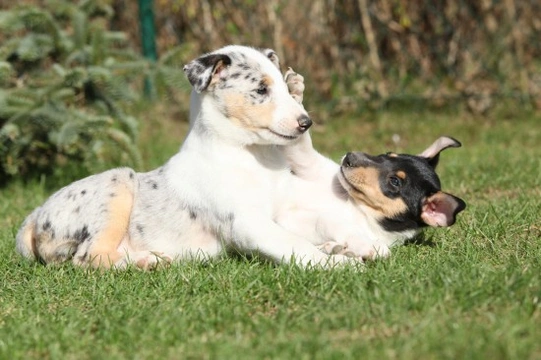
Can you tell the difference between normal play and aggressive play in dogs?
Learning to play appropriately with other dogs is an important life skill that all puppies must learn, and this is one of the reasons why good socialisation when young is so important. Even when puppies are very young and are still with their dam and littermates, they are already learning about the boundaries of acceptable play, the puppies’ relationships to each other, and their personalities and place within the pecking order of the litter.
This learning process develops and grows further when the pups get older and leave the dam, and become faced with strange dogs in new environments for the first time. The basis of every relationship and interaction between two or more dogs is based on a pecking order, and one dog that will become naturally dominant and another submissive. In order to allow for this to happen in meetings and to permit healthy, natural play, it is important to let dogs get to grips with each other, with only the minimum of human intervention.
But can you tell the difference between appropriate fun play, and potential aggression that may require your intervention? Read on to learn more.
Dogs and their boundaries and limits
Every dog has a different understanding of what they class as acceptable play, and what they like to do when playing. Some dogs like very little contact and sedentary interaction, while others love high energy, full contact rough and tumble. Both of these forms of play are fine, as long as the more boisterous dog respects the limits of the quieter dog and backs off when the other dog shows signs of displeasure. It is when one dog refuses to back off when the other one has had enough that problems arise!
Sometimes, the more boisterous dog is not actually the dominant dog; the dominant party can be ascertained by how the dog who wishes to call a halt stops play. A dominant dog will indicate their displeasure by telling the other dog off and physically warning them to back off, while a submissive dog will whine and display submissive body language to ask the other dog to cool things.
How can you tell the difference between play and aggression?
Learning to read the body language of dogs is the key to telling the difference between aggression and normal acceptable play, and this too will let you know when one of the dogs needs a time out.
When both dogs are having fun, tails will be wagging, both dogs will seem alert, switched on and happy, and their body language, while potentially excited, will also be relaxed.
If something changes or goes wrong, the signs that the two dogs give off will change significantly. A dominant dog may tense up, bare their teeth and snarl or growl, potentially with raised hackles, and a submissive dog that has had enough will display a fear response, trying to retreat and cowering, tucking their tail in and attempting to retreat. If the submissive dog feels backed into a corner, they may respond with aggression of their own, and will likely mirror the other dog in their behaviours.
Let your dog learn
It is vitally important not to interrupt play and socialisation unless absolutely necessary, as by doing this, you remove from the dogs the learning experience of building their own relationship together and working out each other’s limits. Too much interference or stepping in too early will only prolong this process, and dogs usually communicate very effectively with each other and rarely need outside intervention.
When should you intervene?
It can be very difficult for the dog owner to know when an intervention is a good idea, and when to leave things well alone! Some dogs, particularly smaller dogs, are adept at making bloodcurdling shrieks and other sounds of pained distress when they are actually fine and just playing the “I am small!” card, and chastising the other dog when the louder dog is just causing a scene will help nobody!
It is important to read all of the signs and body language of the dogs together, rather than looking at isolated signs as your cues. Sometimes, growling and apparent snarling can actually just be a play-display, for instance if the dog is bowing with the front legs and frantically wagging their tail; this is likely to simply be an invitation to the other dog to step the play up a notch. Mouthing at each other, grabbing at each other’s ears and rolling about on the ground are all parts of great fun play for many dogs, and not meant nor read aggressively.
Do not take growling or barking as aggressive signs in their own right, but instead learn to build up a full picture of both dog’s behaviours, and importantly, how this changes as play progresses, to decide whether or not to intervene.



